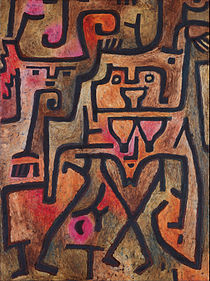Klee
| Paul Klee | |
|---|---|

Paul Klee in 1911
|
|
| Born | 18 December 1879 Münchenbuchsee near Bern, Switzerland |
| Died | 29 June 1940 (aged 60) Muralto, Switzerland |
| Nationality | Swiss |
| Education | Academy of Fine Arts, Munich |
| Known for | Painting, drawing, watercolor, printmaking |
| Notable work | more than 10,000 paintings, drawings, and etchings, including Twittering Machine (1922), Fish Magic (1925), Viaducts Break Ranks (1937). |
| Movement | Expressionism, Bauhaus, Surrealism |
 |
|
|
|
Paul Klee (German: [paʊ̯l ˈkleː]; 18 December 1879 – 29 June 1940) was a Swiss-German artist. His highly individual style was influenced by movements in art that included Expressionism, Cubism, and Surrealism. Klee was a natural draftsman who experimented with and eventually deeply explored color theory, writing about it extensively; his lectures Writings on Form and Design Theory (Schriften zur Form und Gestaltungslehre), published in English as the Paul Klee Notebooks, are held to be as important for modern art as Leonardo da Vinci's A Treatise on Painting for the Renaissance. He and his colleague, Russian painter Wassily Kandinsky, both taught at the Bauhaus school of art, design and architecture. His works reflect his dry humor and his sometimes childlike perspective, his personal moods and beliefs, and his musicality.
First of all, the art of living; then as my ideal profession, poetry and philosophy, and as my real profession, plastic arts; in the last resort, for lack of income, illustrations.
Paul Klee was born in Münchenbuchsee, Switzerland, as the second child of German music teacher Hans Wilhelm Klee (1849–1940) and Swiss singer Ida Marie Klee, née Frick (1855–1921). His sister Mathilde (died 6 December 1953) was born on 28 January 1876 in Walzenhausen. Their father came from Tann and studied at the Stuttgart Conservatory singing, piano, organ and violin, meeting there his future wife Ida Frick. Hans Wilhelm Klee was active as a music teacher at the Bern State Seminary in Hofwil near Bern until 1931. Klee was able to develop his music skills as his parents encouraged and inspired him until his death. In 1880, his family moved to Bern, where they moved 17 years later after numerous changes of residence into a house at the Kirchenfeld district. From 1886 to 1890, Klee visited primary school and received, at the age of 7, violin classes at the Municipal Music School. He was so talented on violin that, aged 11, he received an invitation to play as an extraordinary member of the Bern Music Association.
...
Wikipedia
